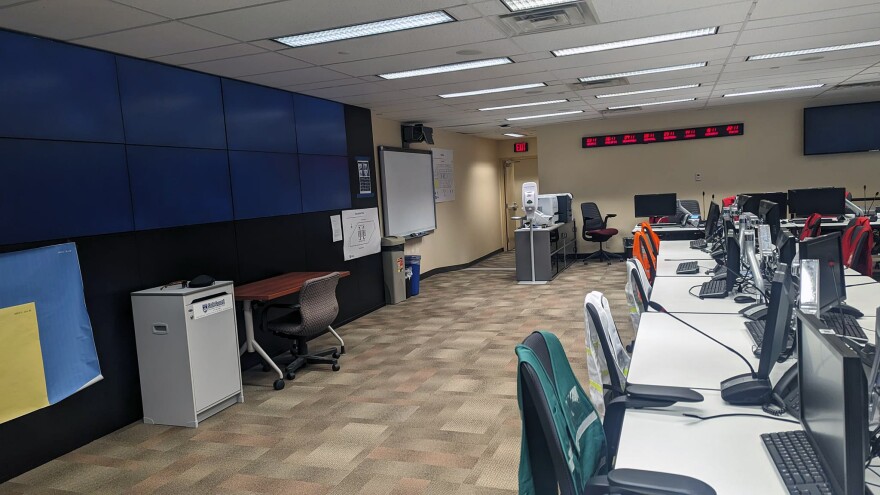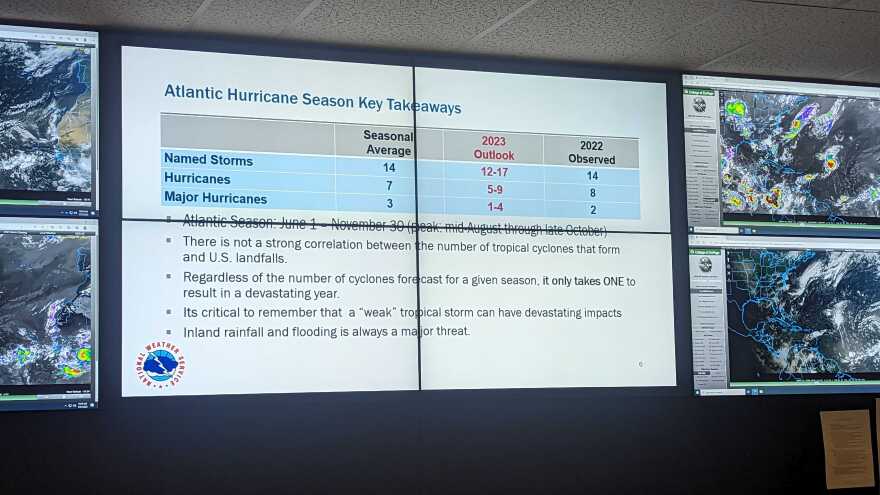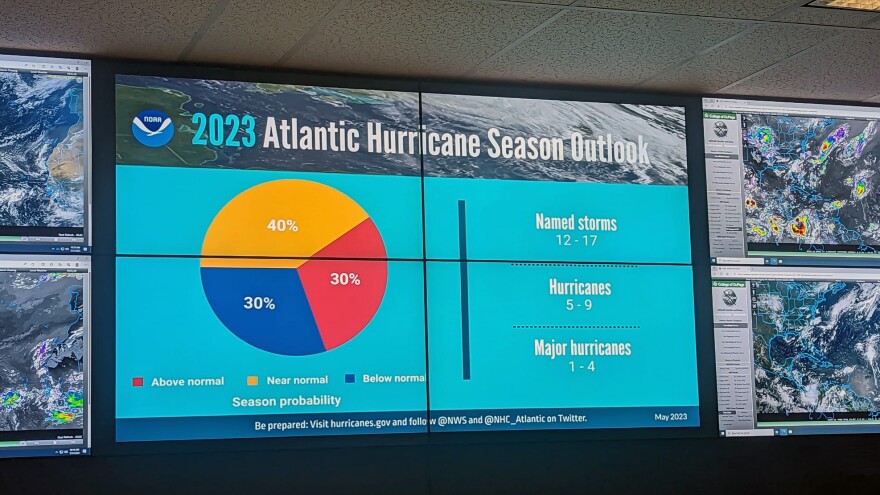PHILADELPHIA — Pennsylvania may not be the most vulnerable state during the Atlantic hurricane season, but emergency planners were particularly blunt Monday about the dangers it faces.
That’s because hurricane season begins to peak on Aug. 1, and some experts feel that changing atmospheric and climatic conditions are likely to produce more storms, and perhaps hurricanes, this year.
- The Federal Emergency Management Agency, or FEMA, Region 3 held a media tour of the Regional Response Coordination Center on Monday to highlight the importance of preparedness ahead of the peak of hurricane season
- Many of the most powerful and destructive hurricanes have occurred from August to October
- Officials said they fear the public “is not taking this as seriously as they could”
But it’s not just the strong winds, tornadoes, heavy rain and inland flooding they’re concerned about.
"The thing I'm most concerned about when it comes to severe weather is apathy,” FEMA Region 3 Regional Administrator MaryAnn Tierney said Monday.
“My big concern is the public not being concerned about hurricanes and not being ready for them. So I think that's really the unique feature of Region 3 is we're just as at-risk as areas in the southern part of the United States.”
“For hurricanes, whether it's the flooding, the wind, the storm surge, we're also at risk for flash flooding, tornadoes. We have a pretty significant hazard profile, but the public is not taking that as seriously as they could."MaryAnn Tierney, FEMA Region 3 Regional Administrator
Region 3 also includes Delaware, Maryland, Virginia, West Virginia and the District of Columbia.
“For hurricanes, whether it's the flooding, the wind, the storm surge, we're also at risk for flash flooding, tornadoes," Tierney said. "We have a pretty significant hazard profile, but the public is not taking that as seriously as they could."
It’s why FEMA opened the doors Monday to its Regional Response Coordination Center, highlighting what officials described as a year-round effort to protect lives and property from hurricane impacts.
Preparedness was the theme as Tierney was joined by several officials, including David Manning, Meteorologist-in-Charge for the National Weather Service’s Eastern Region Regional Operations Center, to discuss the busiest part of hurricane season — August, September and October.
"Regardless of however many systems there are in a given year, it really only takes one to cause devastation in any given area,” Manning said.
“Also, it’s critical to remember that even the big tropical storm by definition that doesn't have the strong winds sometimes has exceptionally heavy rainfall and inland flooding.
"And heavy rainfall is always a major threat with any tropical system."
‘Developing faster, intensifying more rapidly’
Lehigh Valley residents know all too well the destructive nature of tropical storms.
On Sept. 1, 2021, the remnants of Hurricane Ida brought major flooding to the region and was the fifth costliest storm in U.S. history.
The category four storm and its remnants contributed to the deaths of almost 100 people, including five in Pennsylvania, and caused $75 billion in damage.

It came a year after the fast-moving Tropical Storm Isaias wreaked havoc in the region, spawning a tornado outbreak that left considerable damage in Bucks and Montgomery counties.
And that came less than a month after the remnants of Tropical Storm Fay dropped more than 5 inches of rain in parts of the Lehigh Valley, inundating the area with floodwaters that forced evacuations of homes and apartment buildings.
Tierney said it’s imperative to know what actions to take if a storm targets the area, as well as what to do after it departs.
But she said residents need to be more prepared for all storm events, specifically speaking about recent flooding events in Northampton County, where damage has exceeded $7.5 million.
It only takes one storm to change your life and your community, she said.
“Most of the time, when you have an emergency, the first people you're going to interact with are your neighbors," she said. "They're the first people that come and help you after a disaster, right? Neighbors helping neighbors.
"Then it's your first responders in your local community, whether it's the fire department or police department, EMS. They’re going to be supporting you.”
But she stressed the importance of taking action now ahead of severe weather, and those statements were echoed by other emergency planners in the room.
“Disasters are locally managed, state coordinated and federally supported,” Michael Bilder, the hurricane program manager for FEMA Region 3, said.
“Our job at the federal level is to provide whatever support the state and local emergency managers and responders need to do to get things under control and things back to normal. That's what we're primarily focused on."
And Tierney said we’re seeing a lot more activity than we used to in the region.
“Hurricanes today are developing faster and intensifying more rapidly than they have in the past. We’re seeing more tornadoes across the mid-Atlantic than we have in the past as well as increased risk of inland flooding far from the coast.
“I do think that the increasing amount of storms and the different types of hazards that we are facing will continue and will likely increase,” she said.
“I do think that the increasing amount of storms and the different types of hazards that we are facing will continue and will likely increase."MaryAnn Tierney, FEMA Region 3 Regional Administrator
A longer hurricane season?
Manning said hurricane season’s typical peak is still to come as we kick off August. And despite a perceived lull, the season already has had the fourth most active start to any season since 1851, with five storms and one hurricane.
The Atlantic hurricane season runs from June through November, Manning said, but in most years, the first two months of the season are typically the calmest.
June averages only one named storm every other year, and July has averaged one named storm per year since 1950.

“This year, for the 2023 hurricane season, our NOAA scientists are predicting a near normal season, and that is for 12 to 17 named storms,” he said.
Five to nine storms are predicted to become hurricanes and one to four of them expected to become major (corresponding to a Category 3, 4 or 5 on the Saffir-Simpson Hurricane Wind Scale).
“El Niño conditions have developed and that's a big factor in the Atlantic hurricane season,” Manning said. “The stronger the El Niño, the more likely it is to suppress some of the tropical cyclone activity in the Atlantic.
“We're expecting that to peak later this year, which always helps suppress tropical storm activity. However, a lot of the other conditions are also still in play, and that includes well above normal sea surface temperatures in the Atlantic where these tropical systems do develop.”
While we’re approaching the time of year when the most powerful and destructive hurricanes occur, people also need to pay attention beyond that window.
“One thing that we have seen is that we are filling out the hurricane season a lot more," Manning said. "We’re seeing earlier storms in the year, and we're seeing some even later in the year.
“You can go back a few years, and we had storms into December and even in January, several years ago. So the conditions when they come together, we can have a tropical cyclone at any time in the Atlantic basin, as long as the ingredients are in place. So that season is less of a factor than the ingredients.”
To prepare now:
- FEMA’s Ready Campaign recently published a low- and no-cost preparedness webpage with tips to help preparedness for a variety of disasters and emergencies.
- If you have insurance, now is the time to review your policies, officials said. Not all policies are the same, so review them to understand what coverage you have. Homeowners insurance does not typically cover flooding, so you may need to purchase flood insurance.
- FEMA’s Ready Business Hurricane Toolkit helps business owners take action to protect employees, protect customers, and help ensure business continuity.
- Visit Ready.gov/hurricane for specific additional tips to prepare for hurricane systems.


